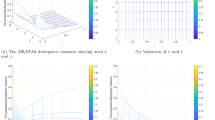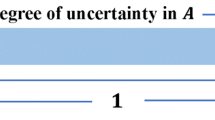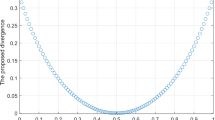Abstract
Multi-source information fusion technology has been widely used because it can maximize the use of information that collected from multiple data sources for decision fusion. As an uncertain information processing theory, Dempster-Shafer (D-S) evidence theory is prevalent in the field of multi-source information fusion. However, there is still room for improvement in the handling of uncertain problems involving highly conflicting evidence sources. For the purpose of improving the practicality and efficiency in handling highly conflicting evidence sources, a new belief Rényi divergence is defined to measure the discrepancy between evidences in D-S evidence theory. The proposed belief Rényi divergence takes belief function (Bel) and plausibility function (Pl) into account, thus allowing it to provide a more rational and telling approach for measuring differences between evidence. Moreover, some important properties of belief Rényi divergence have been studied, the belief Rényi divergence regards to Hellinger distance, Kullback-Leibler divergence and χ2 divergence, which ensures that the metric has a wider range of application scenarios. Based on the proposed belief Rényi divergence measure, a novel multi-source information fusion method is designed. The proposed belief Rényi divergence is used to measure difference between evidence; Deng entropy is used to quantify the uncertainty, thereby calculating information volume of the evidence. Accordingly, the proposed method can fully assess relationship among evidences and information volume of each evidence. Through a comprehensive analysis and experiments, practicality and effectiveness of the proposed method for multi-source information fusion are verified. Finally, an iris dataset-based experiment is implemented to verify the new proposed divergence measure and the multi-source information fusion algorithm has a more extensive applicability.









Similar content being viewed by others
References
Ni L, Chen Y-W, de Brujin O (2021) Towards understanding socially influenced vaccination decision making: An integrated model of multiple criteria belief modelling and social network analysis. Eur J Oper Res 293(1):276–289
Tang M, Liao H, Mi X, Xu X, Herrera F (2020) Dynamic subgroup-quality-based consensus in managing consistency, nearness, and evenness quality indices for large-scale group decision making under hesitant environment. J Oper Res Soc, pp 1–14
Lai JW, Chang J, Ang L, Cheong KH (2020) Multi-level information fusion to alleviate network congestion. Inf Fusion 63:248–255
Fujita H, Ko Y-C (2020) A heuristic representation learning based on evidential memberships: case study of UCI-SPECTF. Int J Approx Reason, vol 120. https://doi.org/10.1016/j.ijar.2020.02.002
Garg H, Chen S (2020) Multiattribute group decision making based on neutrality aggregation operators of q-rung orthopair fuzzy sets. Inf Sci 517:427–447
Wang Z, Xiao F, Ding W (2022) Interval-valued intuitionistic fuzzy Jenson-Shannon divergence and its application in multi-attribute decision making. Appl Intell. https://doi.org/10.1007/s10489--022--03347--0
Liu Y-T, Pal NR, Marathe AR, Lin C-T (2017) Weighted fuzzy dempster–shafer framework for multimodal information integration. IEEE Trans Fuzzy Syst 26(1):338–352
Zhou M, Liu X-B, Chen Y-W, Qian X-F, Yang J-B, Wu J (105110) Assignment of attribute weights with belief distributions for MADM under uncertainties. Knowl-Based Syst 189:2020
Wang H, Fang Y-P, Zio E (2021) Risk assessment of an electrical power system considering the influence of traffic congestion on a hypothetical scenario of electrified transportation system in new york state. IEEE Trans Intell Transp Syst 22(1):142–155
Danilo P, Nagaraj B, Ganesan S (2021) A special section on emerging challenges and impacts of computational intelligence in medical signal processing applications. J Med Imaging Health Inform. https://doi.org/10.1166/jmihi.2021.3678
Wang Z, Li Z, Wang R, Nie F, Li X (2021) Large graph clustering with simultaneous spectral embedding and discretization. IEEE Trans Pattern Anal Mach Intell 43(12):4426–4440. https://doi.org/10.1109/TPAMI.2020.3002587
Liu Z, Liu Y, Dezert J, Cuzzolin F (2020) Evidence combination based on credal belief redistribution for pattern classification. IEEE Trans Fuzzy Syst 28(4):618–631
Cao Z, Chuang C-H, King J-K, Lin C-T (2019) Multi-channel EEG recordings during a sustained-attention driving task. Sci Data, vol 6. https://doi.org/10.1038/s41597--019--0027--4
Meng D, Xie T, Wu P, He C, Hu Z, Lv Z (2021) An uncertainty-based design optimization strategy with random and interval variables for multidisciplinary engineering systems. In: Structures, Vol 32. Elsevier, pp 997–1004
Cheong KH, Koh JM, Jones MC (2019) Paradoxical survival: examining the parrondo effect across biology. BioEssays 41(6):1900027
Meng D, Li Y, He C, Guo J, Lv Z, Wu P (2021) Multidisciplinary design for structural integrity using a collaborative optimization method based on adaptive surrogate modelling. Mater Des 206:109789
Wang Z, Jusup M, Guo H, Shi L, Geček S, Anand M, Perc M, Bauch CT, Kurths J, Boccaletti S et al (2020) Communicating sentiment and outlook reverses inaction against collective risks. Proc Natl Acad Sci 117(30):17650–17655
Jiang W, Xie C, Zhuang M, Shou Y, Tang Y (2016) Sensor data fusion with z-numbers and its application in fault diagnosis. Sensors 16(9):1509
Wei B, Xiao F, Fang F, Shi Y (2021) Velocity-free event-triggered control for multiple euler–lagrange systems with communication time delays. IEEE Trans Autom Control 66(11):5599–5605
Gao X, Su X, Qian H, Pan X (2021) Dependence assessment in human reliability analysis under uncertain and dynamic situations
Deng X, Jiang W (2020) On the negation of a dempster–shafer belief structure based on maximum uncertainty allocation. Inf Sci 516:346–352
Deng Y (2022) Random permutation set. Int J Comput Commun Control 17(1):4542. https://doi.org/10.15837/ijccc.2022.1.4542
Feng F, Cho J, Pedrycz W, Fujita H, Herawan T (2016) Soft set based association rule mining. Knowl-Based Syst 111:268–282
Cheng C, Xiao F (2021) A distance for belief functions of orderable set. Pattern Recogn Lett 145:165–170
Zhou Z, Feng Z, Hu C, Hu G, He W, Han X (2020) Aeronautical relay health state assessment model based on belief rule base with attribute reliability. Knowl-Based Syst 197:105869
Chang L, Zhang L, Fu C, Chen Y-W (2021) Transparent digital twin for output control using belief rule base. IEEE Trans Cybern. https://doi.org/10.1109/TCYB.2021.3063285
Gao Q, Wen T, Deng Y (2021) Information volume fractal dimension. Fractals 29(8):2150263. https://doi.org/10.1142/S0218348X21502637
Li D, Deng Y (2021) Measure information quality of basic probability assignment: An information volume method. Appl Intell. https://doi.org/10.1007/s10489--021--03066--y
Wang Z, Wang C, Gao C, Li X, Li X (2020) An evolutionary autoencoder for dynamic community detection. Sci China Inf Sci 63(11):1–16
Wen T, Cheong KH (2021) The fractal dimension of complex networks: A review. Inf Fusion 73:87–102
Wang Z, Wang C, Li X, Gao C, Li X, Zhu J (2020) Evolutionary markov dynamics for network community detection. IEEE Trans Knowl Data Eng, pp 1–1. https://doi.org/10.1109/TKDE.2020.2997043
Song X, Xiao F (2022) Combining time-series evidence: A complex network model based on a visibility graph and belief entropy. Appl Intell. https://doi.org/10.1007/s10489--021--02956--5
Wang H, Abdin AF, Fang Y-P, Zio E (2021) Resilience assessment of electrified road networks subject to charging station failures. Comput-Aided Civ Infrastruct Eng. https://doi.org/10.1111/mice.12736
Chen L, Deng Y, Cheong KH (2021) Probability transformation of mass function: A weighted network method based on the ordered visibility graph, vol 105
Xiong L, Su X, Qian H (2021) Conflicting evidence combination from the perspective of networks. Inf Sci 580:408–418
Ye J, Zhan J, Ding W, Fujita H (2021) A novel fuzzy rough set model with fuzzy neighborhood operators. Inf Sci 544:266–297
Yager RR, Elmore P, Petry F (2017) Soft likelihood functions in combining evidence. Inf Fusion 36:185–190
Xu X, Zheng J, Yang J-B, Xu D-L, Chen Y-W (2017) Data classification using evidence reasoning rule. Knowl-Based Syst 116:144–151
Dempster A (1967) Upper and lower probabilities induced by a multivalued mapping. Ann Math Stat 38(2):325–339
Shafer G (1976) A Mathematical Theory of Evidence, Vol 42. Princeton University Press
Fei L, Lu J, Feng Y (2020) An extended best-worst multi-criteria decision-making method by belief functions and its applications in hospital service evaluation. Comput Ind Eng 142:106355
Xiao F (2021) CaFtR: A fuzzy complex event processing method. Int J Fuzzy Syst. https://doi.org/10.1007/s40815--021--01118--6
Han D, Dezert J, Yang Y (2016) Belief interval-based distance measures in the theory of belief functions. IEEE Trans Syst Man Cybern Syst 48(6):833–850
Xie D, Xiao F, Pedrycz W (2021) Information quality for intuitionistic fuzzy values with its application in decision making. Eng Appl Artif Intell. https://doi.org/10.1016/j.engappai.2021.104568
Deng J, Deng Y (2021) Information volume of fuzzy membership function. Int J Comput Commun Control 16(1):4106
Wang X, Song Y (2018) Uncertainty measure in evidence theory with its applications. Appl Intell 48(7):1672–1688
Xiao F (2020) Generalized belief function in complex evidence theory. J Intell Fuzzy Syst 38 (4):3665–3673
Liu P, Gao H (2019) Some intuitionistic fuzzy power bonferroni mean operators in the framework of Dempster–Shafer theory and their application to multicriteria decision making. Appl Soft Comput 85:105790
Yager RR (2019) Generalized Dempster–Shafer structures. IEEE Trans Fuzzy Syst 27(3):428–435
Xiao F (2020) Evidence combination based on prospect theory for multi-sensor data fusion. ISA Trans 106:253–261
Deng Y (2020) Uncertainty measure in evidence theory. Sci China Inf Sci 63(11):1–19
Murphy CK (2000) Combining belief functions when evidence conflicts. Decis Support Syst 29 (1):1–9
Xiao F (2019) Multi-sensor data fusion based on the belief divergence measure of evidences and the belief entropy. Inf Fusion 46:23–32
Rényi A (1961) On measures of entropy and information. In: Proceedings of the Fourth Berkeley Symposium on Mathematical Statistics and Probability, Volume 1: Contributions to the Theory of Statistics, University of California Press. Berkeley, pp 547-561
Babajanyan S, Allahverdyan A, Cheong KH (2020) Energy and entropy: path from game theory to statistical mechanics. Phys Rev Res 2(4):043055
Yu R, Deng Y (2022) A generalization of Rényi entropy for basic probability assignment. Communications in Statistics-Theory and Methods. https://doi.org/10.1080/03610926.2022.2037646
Cui H, Zhou L, Li Y, Kang B (2022) Belief entropy-of-entropy and its application in the cardiac interbeat interval time series analysis. Chaos, Solitons & Fractals 155:111736. https://doi.org/10.1016/j.chaos.2021.111736
van Erven TAL (2010) When data compression and statistics disagree: two frequentist challenges for the minimum description length principle, Ph.D. thesis, Leiden University
Morales D, Pardo L, Vajda I (2000) Rényi statistics in directed families of exponential experiments. Statistics: A Journal of Theoretical and Applied Statistics 34(2):151–174
Mansour Y, Mohri M, Rostamizadeh A (2009) Multiplesource adaptation and the Rényi divergence. In: UAI, pp 367–374
Hero AO, Ma B, Michel O, Gorman J (2001) Alpha-divergence for classification, indexing and retrieval. In: University of Michigan, Citeseer
Wang H, Deng X, Jiang W, Geng J (2021) A new belief divergence measure for Dempster–Shafer theory based on belief and plausibility function and its application in multi-source data fusion. Eng Appl Artif Intell 97:104030
Van Erven T, Harremos P (2014) Rényi divergence and Kullback-Leibler divergence. IEEE Trans Inf Theory 60(7):3797–3820
Liu F, Gao X, Zhao J, Deng Y (2019) Generalized belief entropy and its application in identifying conflict evidence. IEEE Access 7:126625–126633
Deng Y (2020) Information volume of mass function. Int J Comput Commun Control 15(6):3983
Deng Y, Shi W, Zhu Z, Liu Q (2004) Combining belief functions based on distance of evidence. Decis Support Syst 38(3):489–493
He Y, Xiao F (2021) Conflicting management of evidence combination from the point of improvement of basic probability assignment. Int J Intell Syst 36(5):1914–1942
Gao X, Xiao F (2022) A generalized χ 2 divergence for multisource information fusion and its application in fault diagnosis. Int J Intell Syst 37(1):5–29
Acknowledgements
The authors greatly appreciate the reviewers' suggestions and the editors encouragement. This research is supported by the National Natural Science Foundation of China\break (No. 62003280), Chongqing Talents: Exceptional Young Talents Project (cstc2022ycjh-bgzxm0070), and Chongqing Overseas Scholars Innovation Program (No. cx2022024).
Author information
Authors and Affiliations
Corresponding author
Additional information
Publisher’s note
Springer Nature remains neutral with regard to jurisdictional claims in published maps and institutional affiliations.
Rights and permissions
About this article
Cite this article
Zhu, C., Xiao, F. A belief Rényi divergence for multi-source information fusion and its application in pattern recognition. Appl Intell 53, 8941–8958 (2023). https://doi.org/10.1007/s10489-022-03768-x
Accepted:
Published:
Issue Date:
DOI: https://doi.org/10.1007/s10489-022-03768-x




